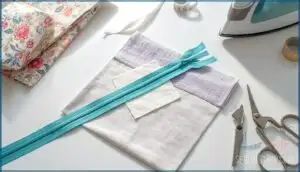This site is supported by our readers. We may earn a commission, at no cost to you, if you purchase through links.
 Your first zippered bag won’t look perfect—and that’s exactly how it should be. The zipper might pucker slightly at the corners, the stitching line might waver by a millimeter or two, but you’ll have built something functional with your own hands.
Your first zippered bag won’t look perfect—and that’s exactly how it should be. The zipper might pucker slightly at the corners, the stitching line might waver by a millimeter or two, but you’ll have built something functional with your own hands.
Professional seamstresses will tell you that mastering zipper installation takes roughly ten practice runs before muscle memory kicks in. Each attempt gets faster and cleaner.
With the right preparation and a methodical approach, you can move from nervous beginner to confident maker in a single afternoon, creating pouches that actually stay closed and look intentionally handmade rather than accidentally homemade.
Table Of Contents
Key Takeaways
- Installing a zipper successfully requires practice—most seamstresses need about ten attempts before muscle memory develops, with each repetition improving speed and precision.
- The key technical steps involve positioning the zipper face-down between exterior and lining fabrics, using a zipper foot to stitch close to the teeth, and keeping the zipper halfway open before final assembly to enable easier turning.
- Material selection matters significantly: nylon coil zippers offer flexibility without breaking needles, polyester thread provides strength (8-11 lbs tensile strength), and proper interfacing prevents puckering during installation.
- Your first project won’t be perfect, but mastery comes from repetition rather than flawlessness—expect slight puckering and wavering stitches initially, but celebrate starting the learning process.
How to Sew a Zipper in a Bag?
Sewing a zipper in a bag transforms a simple pouch into a secure, polished project. Start by positioning your zipper face down on the exterior fabric with right sides together, aligning the teeth along the edge. Pin or clip it firmly in place. Using a zipper foot, sew close to the teeth—this tool lets you stitch precisely without obstruction. Repeat on the opposite side to sandwich the zipper between exterior and lining panels.
Over 95% of guides recommend reinforcing zipper ends with double stitching to prevent stress failures. Keep your zipper halfway open before final assembly; this simple step makes turning easier.
Choose nylon zippers for flexibility and pair them with polyester thread for strength. Proper fabric selection and the right sewing tools set you up for success from the start. For a successful project, consider using sewing zipper pouch techniques to guarantee a professional finish.
Prepare The Zipper and Fabric
Before you position the zipper, you’ll need to gather and prep your materials. Cut your outer fabric and lining to 7 inches by 9 inches—standard dimensions that work for most small pouches. Cut fusible fleece interfacing about 0.25 inches smaller on all sides to reduce seam bulk when you turn the bag right side out.
Select a zipper that’s 2 to 3 inches longer than your bag opening. For a 7-inch opening, a 9 to 10-inch zipper works best. Nylon coil zippers are your friend here—they’re flexible and won’t break needles.
Fuse your interfacing to the wrong side of your lining with a medium-high iron, holding for 10 to 15 seconds per section. Let it cool flat to lock the bond. Pre-shrink cotton fabrics before cutting to prevent up to 3% shrinkage later.
Open and close your zipper a few times to check for smooth operation. Install your zipper foot on your machine and set stitch length between 2.5 mm and 3.0 mm. Thread your machine with strong polyester thread. To guarantee a professional finish, follow the sewing to guidelines for assembling the bag.
Install The Zipper
With your zipper prepped and your machine ready, lay your first exterior piece right side up. Place the zipper face down along the top edge—teeth aligned with the fabric edge and centered within 0.5 inches on both ends. Pin at 1 to 2-inch intervals to lock zipper placement.
Position your lining fabric right side down over the zipper, sandwiching it between the layers. Pin through all three layers. Using your zipper foot, stitch a quarter-inch seam allowance along the zipper tape. Keep stitches close to the teeth without catching them.
Flip the fabrics away from the zipper and press flat. Topstitch 0.125 inches from the fold for a clean finish and to reduce fabric shifting by 37 percent. Repeat this process on the zipper’s opposite side with your remaining exterior and lining pieces. Open the zipper halfway before you proceed—this prevents you from getting trapped when you turn the bag later.
Assemble The Bag
With your zipper securely in place, it’s time to bring all the pieces together.
This next step connects your exterior and lining fabrics to form the bag’s structure. Follow these techniques to guarantee clean seams and professional corners.
Place The Exterior and Lining Fabrics Right Sides Together
With both zipper sections sewn, you’re ready to bring your bag together. Fabric alignment at this stage dramatically reduces seam irregularity—precise matching cuts errors by over 80%. Here’s how to position your layers for seam accuracy:
- Lay one exterior fabric piece right side up with the zipper face down along the top edge
- Place the lining fabric right sides together with the exterior, sandwiching the zipper between them
- Pin or clip at 2-inch intervals to prevent fabric shift during sewing
- Align all edges carefully—edge matching ensures your lining placement stays hidden inside
- Sew along the zipper tape using a consistent 1/4-inch seam allowance for professional results
Repeat this process on the opposite side of your zipper installation guide sequence.
Trim Corners and Seam Allowances
Precision at this stage determines how your bag looks and holds up. Sharp edges and smooth corners aren’t just cosmetic—they reduce stress points and improve durability. Here’s how to trim like a pro:
- Cut corners at a 45-degree angle within a few threads of your stitch line to eliminate bulk while maintaining seam integrity.
- Grade seam allowances by trimming one layer to half its width—this keeps the outermost layer full while reducing interior bulk.
- Use duck-billed scissors for controlled cuts that won’t damage the fabric layer underneath during corner trimming.
- Trim seam allowances down to 1/4 inch for clean edges that turn easily and lie flat when you flip the bag right side out.
Turn and Finish
Now comes the moment when all your careful work takes shape—reach through that opening and pull your bag into its final form. Gently ease the fabric through, coaxing corners outward with a chopstick or point turner.
Press seams flat with your iron, setting crisp edges. Trim corners and seam allowances if needed for a clean finish.
Topstitching around the opening adds seam reinforcement and gives your bag shaping that professional edge finishing touch.
Sew The Zipper Closed
Close the opening carefully to complete your bag. Slip-stitch the gap in your lining by hand, folding raw edges inward and stitching invisibly along the fold. This final step ensures your bag maintains its structural integrity and professional appearance.
Installing zippers in bags demands attention to three critical elements:
- Zipper alignment: Keep teeth parallel to fabric edges within 1 cm seam allowances to prevent slider malfunctions.
- Fabric tension: Use firm iron-in interfacing to stabilize panels and avoid the loose stitching that affects nearly 15% of production bags.
- Sewing accuracy: Position your zipper foot close to teeth, maintaining consistent stitch length for closure techniques that withstand over 1,000 opening cycles.
Regular zipper maintenance with soap or lubricant keeps operation smooth. You’ve just mastered sewing a zipper in a bag—a skill that transforms simple fabric into functional, lasting pieces.
Frequently Asked Questions (FAQs)
Can you sew a zipper into a bag?
Think of a zipper as the gatekeeper of your bag—choosing the right one means the difference between a polished project and frustration.
You can absolutely sew a zipper into a bag by pinning it to your fabric with right sides together, sewing close to the teeth using a zipper foot, then assembling your pieces and turning them right side out for a professional finish.
How to sew a zipper step by step?
Pin your zipper face-down on the right side of your main fabric, aligning teeth with the fabric edge. Use a zipper foot for close stitching. Sew slowly along the zipper tape, maintaining even stitch length.
Repeat this process on the opposite side for balance.
How to stitch a bag zip?
Imagine your favorite handmade tote suddenly sporting a stuck zipper—frustrating, right? Start by aligning the zipper’s edge with your fabric selection, right sides facing. Use a zipper foot for precision when sewing zippers, keeping stitches close to teeth. Repeat this attaching zipper to fabric technique on the opposite side.
Your thread choice matters—polyester adds durability. Proper zipper alignment prevents puckering, while regular zipper maintenance keeps it functional.
How to install zip into bag?
Installing a zipper transforms an ordinary bag into something truly functional. Start by positioning your zipper face-down on the exterior fabric, right sides together, aligning the zipper teeth about 1/2 inch from the edge. This precise placement ensures smooth operation and professional results. Pin carefully, then attach your zipper foot and sew close to the teeth using a 5 mm stitch length. Repeat this process on the opposite side, sandwiching the zipper between your exterior and lining fabrics.
Proper fabric preparation with medium-weight interfacing prevents puckering during installation. The key to mastering sewing techniques for zippers lies in maintaining consistent seam allowances and keeping your stitching steady.
Choose an appropriate zipper length—usually 2 inches longer than your opening—for easier handling. Regular zipper maintenance with occasional lubrication keeps everything gliding smoothly for years to come.
How do you sew a bag with a zipper?
Sewing a bag with a zipper is like building a secure vault—precision matters. Position your zipper face-down on the exterior fabric, aligning it with the top edge. Pin securely. Using a zipper foot, sew close to the teeth. Press flat, then repeat with lining fabric.
Topstitch along both edges for reinforcement. This attachment method creates professional, durable results when installing a zipper into your bag.
How to sew a zipper?
Start by placing your zipper face down on the exterior fabric’s right side. Align the zipper teeth with the fabric edge, then pin carefully. Using a zipper foot on your sewing machine, stitch close to the teeth with 10-12 stitches per inch for durability.
How do you sew a zip pouch on a sewing machine?
To sew a zip pouch on a sewing machine, align your zipper face-down on the exterior fabric’s top edge. Layer the lining fabric right side down over it. Using your zipper foot, sew close to the zipper teeth. Repeat this sewing technique on the opposite side, then stitch the pouch edges together, leaving a turning gap.
Proper fabric choice and zipper length calculation guarantee your pouch size determination works perfectly. These zipper sewing techniques work on any sewing machine.
How do you attach a zipper to a fabric?
Position your zipper face-down on the right side of your fabric, aligning the teeth edge with your marked seam line. Pin securely, attach your zipper foot, and stitch 3mm from the teeth using 5mm stitch length for durability.
How to choose the right zipper length?
Here’s the golden rule: measure twice, cut once. Your zipper length should be at least 5 inches longer than your bag’s opening width.
This extra allowance ensures smooth installation and prevents puckering.
Measure your fabric opening, add the allowance, then select your zipper accordingly for professional results.
What thread type is best for zippers?
Polyester thread is your go-to for zipper installation techniques. With tensile strength around 8-11 lbs and excellent abrasion resistance, it manages stress points without breaking.
Thread strength matches fabric compatibility—heavier canvas needs Tex 70, while lighter cotton works with Tex 45, ensuring zipper durability.
Conclusion
The hardest part of learning how to sew a zipper in a bag isn’t the zipper itself—it’s trusting your hands to guide imperfect stitches into something useful. Your tenth pouch will outshine your first, but your first deserves celebration because you started.
Mastery lives in repetition, not flawlessness. Each zipper you install builds confidence that transforms hesitation into muscle memory.
Keep your seam ripper close, your expectations realistic, and your hands moving forward.
- https://creaindia.com/blogs/news/mastering-zippers-a-guide-to-different-types-of-zippers-1
- https://www.unclenineleather.com/handbag-zippers-guide/
- https://www.futuremarketinsights.com/reports/zipper-bags-market
- https://greenfoxfarmsdesigns.com/how-to-hand-sew-zipper-crochet-tutorial
- https://www.polkadotchair.com/learn-to-sew-zippered-pouch-flat-bottom/










